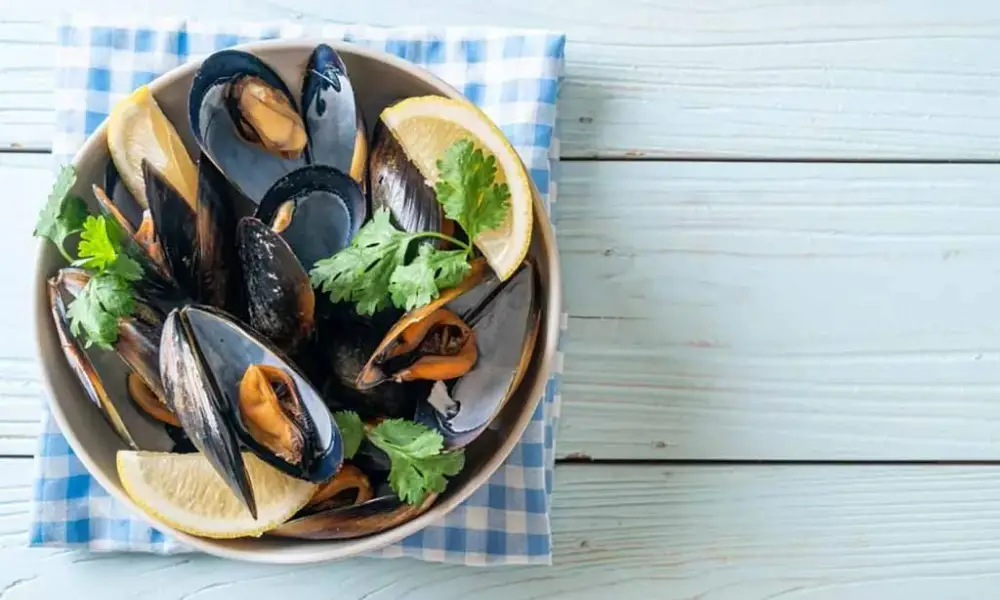Cooking fresh mussels is simple and delicious. But it helps to store them properly to keep them tasty, fresh, and safe to eat. The uncooked mussels can be kept for a few days in the refrigerator or for up to three months in the freezer. After cooking them, you can store them in the freezer or refrigerator for a later date.

How to Store Live Mussels in the Fridge?
- The mussels should be put in a bowl or on a tray. You must get started on preparing your live mussels for storage as soon as you get them home. Put the mussels in a bowl or on a plate after removing them from the bag or container they were packaged in. It shouldn’t matter how they are arranged; stacking them high in the container shouldn’t harm them.
- The mussels can be kept in a colander on top of a dish if you’d like. This will let any liquid that the mussels create flow out.
- Don’t keep your mussels in a bag or container that is tightly closed. They require an open container so they may breathe.
- Use a paper towel or clean, damp cloth to cover the container. This will aid in moisture retention without suffocating the mussels. The mussels shouldn’t have any water added to them because doing so could kill them and cause them to spoil. By placing an ice bag with a zippered cover on top of the mussels and beneath the cloth or paper towel, you may keep them cool. However, avoid letting the ice come into close touch with the mussels.
- The lowest shelf of your refrigerator should hold the mussels. Keep the mussels away from other foods in your refrigerator so that they can’t leak or drip on them. Keeping your mussels in the bottom of the refrigerator can also help them stay well-chilled because that area is typically the coolest, especially toward the back.
- Be careful not to let your mussels become frozen, as this will cause their death. A temperature range between 39 °F (4 °C) and 46 °F (8 °C) is recommended for storage.
- Every day, check your mussels and drain any liquid. Every day, the mussels will secrete a small amount of liquid. This liquid will gather in the container if you don’t keep them in a self-draining container (like a colander). To keep your mussels as fresh and healthy as possible, drain any liquid daily.
- Empty the tray or dish underneath your mussels if you’re storing them in a colander frequently to avoid a buildup of liquid that can spill over and leak into your refrigerator.
- The mussels should only be kept for three to four days. If you store your mussels properly, they should remain alive for a few days if they were fresh when you bought them. Ideally, you should prepare and consume your mussels no later than two days after purchasing them.
- Mussels that have been kept in the refrigerator for more than four days should be thrown away.
- Make sure the mussels are still fresh before boiling them. The mussels should be thoroughly examined before cooking. Search for broken shells, and tap any shells that are open to ensure that they close. Your mussels need to smell lightly salty and oceanic.
- Wait until you’re ready to boil your mussels before washing and debearding them because doing so can cause the mussels to perish.
How to Store Cooked Mussels in the Freezer?
- The mussels should be taken out of the shells. The mussels should be cooked, and those that you want to freeze should be set aside. To get the meat out, carefully pry open the shells. If the mussels are cooked through, the meat can be readily removed using a spoon or knife.
- Wait until the mussels are completely cool if you’ve just finished cooking them before removing the shells. Otherwise, they could be uncomfortable to handle due to heat.
- After cooking, if any mussels are still closed, you can gently pry them apart by slipping a knife between the two halves of the shell.
- Contrary to popular belief, you can consume cooked mussels that are still closed as long as they were fresh when you cooked them.
- Put the mussels in a freezer-safe container that won’t leak. Choose a container that is durable and has a tight-fitting lid. Another choice is to use a freezer bag, but be sure to pick one that shuts securely and can keep the mussels and their broth without leaking.
- Put the mussels in the container however you like. Simply spread them out so the cooking liquid can cover them.
- In the broth, you used to boil the mussels, and cover them. Pour enough of the cooking liquid into the container to completely cover the mussels after they have been added. The flavor of the mussels will be preserved thanks to this.
- Give the broth some time to cool before adding it to the container to prevent burning yourself.
- For up to 4 months, keep the sealed container in your freezer. After adding the broth, firmly screw on the lid or, if you used a bag, zip the top. With a permanent marker, mark the date on the container or bag. For up to 4 months after cooking, your mussels should retain their quality.
- Your mussels could get a little mushy or lose some of their flavor after 4 months.
How to Store Mussels in a Mesh Bag?
Once you’ve caught mussels, it’s time to store them safely. The best way to do this is by using a mesh bag. The mesh will keep mussels closed, so they don’t spill water out. Be sure to cover them with a damp cloth or place some ice inside of the bag to keep them cold. You can also place the mussels in a colander and cover it with damp paper towels to keep them from drying out. Regardless of how you store them, be sure to cook them within two days of purchase.
When buying mussels, make sure you buy them at the market. If you’re unsure, look for those that are shiny and wet. Look for a tag that shows the harvest location and date of harvest. Make sure that they smell fresh and smell like the ocean. They also should close completely when you tap them. If they don’t, or if their shells crack, discard them. These tips will help you maintain the freshness of your mussels for a longer period of time.
What are the Tips for Preparing Mussels?
- Because mussels naturally open and close their shells out of the water, give the mussels a thorough cleaning under running water. Mussels that do not close after this should be tapped on a kitchen surface or gently squeezed while they are under running water. If they are still open, throw them away.
- In a preheated pot, add the mussels, and then cover with the lid.
- Add our delectable Mariniere sauce to the saucepan. Cooking time will vary depending on the heat intensity, amount of liquid used, and the number of mussels.
- They are prepared for serving when a sizable amount of steam begins to escape from the pot.
What are the Risks of Eating Dead Mussels?
Contamination of Water
The risk of infection and chemical poisoning is higher when mussels are taken from tainted water sources. Researchers from the U.S. Fish and Wildlife Service in Raleigh, North Carolina, found contaminated waters with high concentrations of copper, chlorine, and ammonia in three drainages that affect freshwater mussels in the state. By drainage and place, pollution levels change. Prior to making a purchase, finding out where the mussels are from will help you lower your risk of developing any health issues.
Heavy Metal Pollution
The risk of brain impairment and birth problems can arise when heavy metals like mercury, cadmium, or lead are present in mussels. Significant variations in the number of heavy metals in mussels were discovered along the Western Mediterranean Sea’s coastline, according to research from the Instituto Espanol de Oceanografia in Murcia, Spain, that was published in the “Journal of Environmental Monitoring” in May 2011. The quantities of heavy metals in the rivers are reportedly impacted by the runoff of water from industrial activity that includes chemicals and minerals from the land.
Infection with Adenovirus
Your risk of infection is increased by the presence of adenoviruses in mussels. Adenoviruses cause respiratory, bladder, and gastrointestinal infections that can lead to pneumonia, diarrhea, and rashes. High percentages of blue mussels contaminated with adenovirus were found, according to research from the Royal Swedish Academy of Sciences in Fiskebackskil, Sweden, that was published in the “International Journal of Food Microbiology” in February 2007. The experts come to the conclusion that a crucial element impacting food safety is the very variable rate and sporadic occurrence of accumulated viruses.
How to De-Grease and Clean Mussels?
Soak Mussels in Freshwater
Spend about 20 minutes soaking your mussels in freshwater before cooking. The mussels filter water and expel sand as they breathe. The amount of salt and sand the mussels have inside their shells will decrease after around 20 minutes.
Trim the Mustache
The majority of mussels have what is known as a “beard,” or byssal threads. Numerous threads that protrude from the mussel’s shell make up the beard.
To remove the beard, grip it firmly and pull it away from the hinge end of the mussel while holding the mussel in one hand and covering the other with a dry towel. The mussel won’t be killed by this technique. However, if you were to pull the beard out in the direction of the opening end of the mussel, you may tear it and kill it. Toss the byssal strands away.
Switch to Fresh Water
Transfer the mussels from the contaminated water to a fresh bowl of cold water. The sand has settled to the bottom of the bowl, and if you pour the mussels and unclean water into a strainer, you’ll wind up putting the sand back on top of the mussels.
Clean and Rinse
Any extra sand, barnacles, or other maritime affixes should be removed with a vigorous brush. The mussels should be rinsed in cool tap water before being placed aside. Towel-dry the surface before cooking.
What are the Nutrition Facts of Mussel?
The approximate yield from one pound of mussels in the shell, or 3.5 ounces, compares to the same quantity of other proteins as follows:
Calories
Mussels steamed: 172
Lean flank steak using a grill: 192
Roasted chicken breast, skinless: 164
Protein
24g of steamed mussels
Lean flank steak, grilled, 28g
Skinless roasted chicken breast, 31g
Fat
Mussels steamed: 4 g
8 g lean flank steak, grilled
Roasted chicken breast without the skin: 4 g
Unhealthy Fat
mussels steamed: 1 g
Lean flank steak with a grill: 3 g
Roasted chicken breast without the skin: 1 g
Iron
7g milligrams of steamed mussels
Lean flank steak, grilled, 2 mg
Roasted chicken breast, skin removed, 1 milligram
Sodium
mussels steamed 369 mg
56 mg lean flank steak, grilled
Roasted chicken breast, skinless, 73 mg
Selenium
90 mcg of steamed mussels
Lean flank steak, grilled, 31 mcg
Roasted chicken breast, skinless, 27 mcg
Vitamin C
14 milligrams of steaming mussels
0 mg lean flank steak, grilled
Roasted chicken breast, skin removed, 0 mg
Conclusion
Mussels can be a versatile ingredient in a variety of dishes and are easy to store. They have two hinged shells and filter water from the surrounding ocean. When shucked, mussels have a plump, fresh smell and meat that can range from yellow to deep orange. Their shells are made up of tiny pearls which form in response to biological and physical stress. However, mussels that are broken or dry should be discarded.
